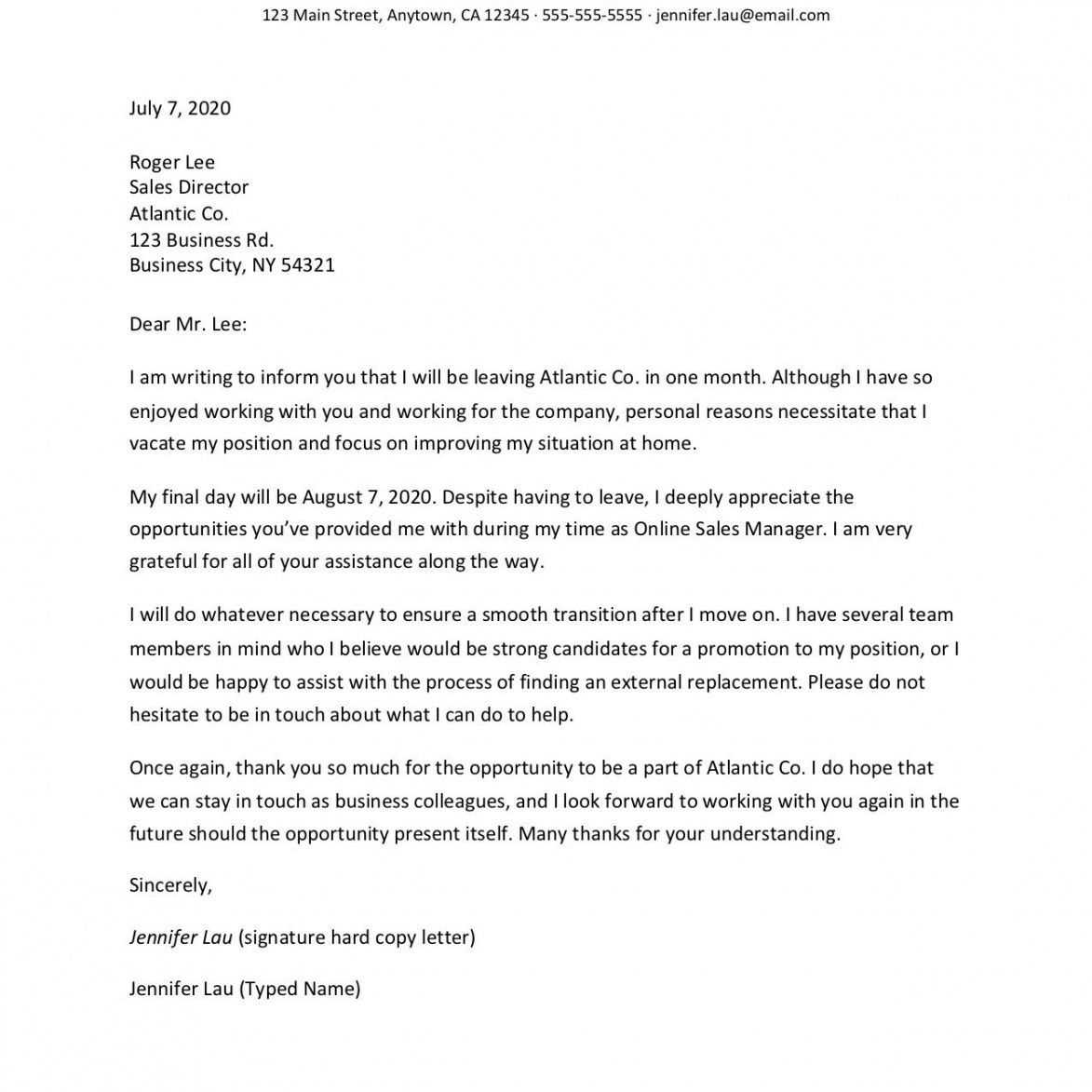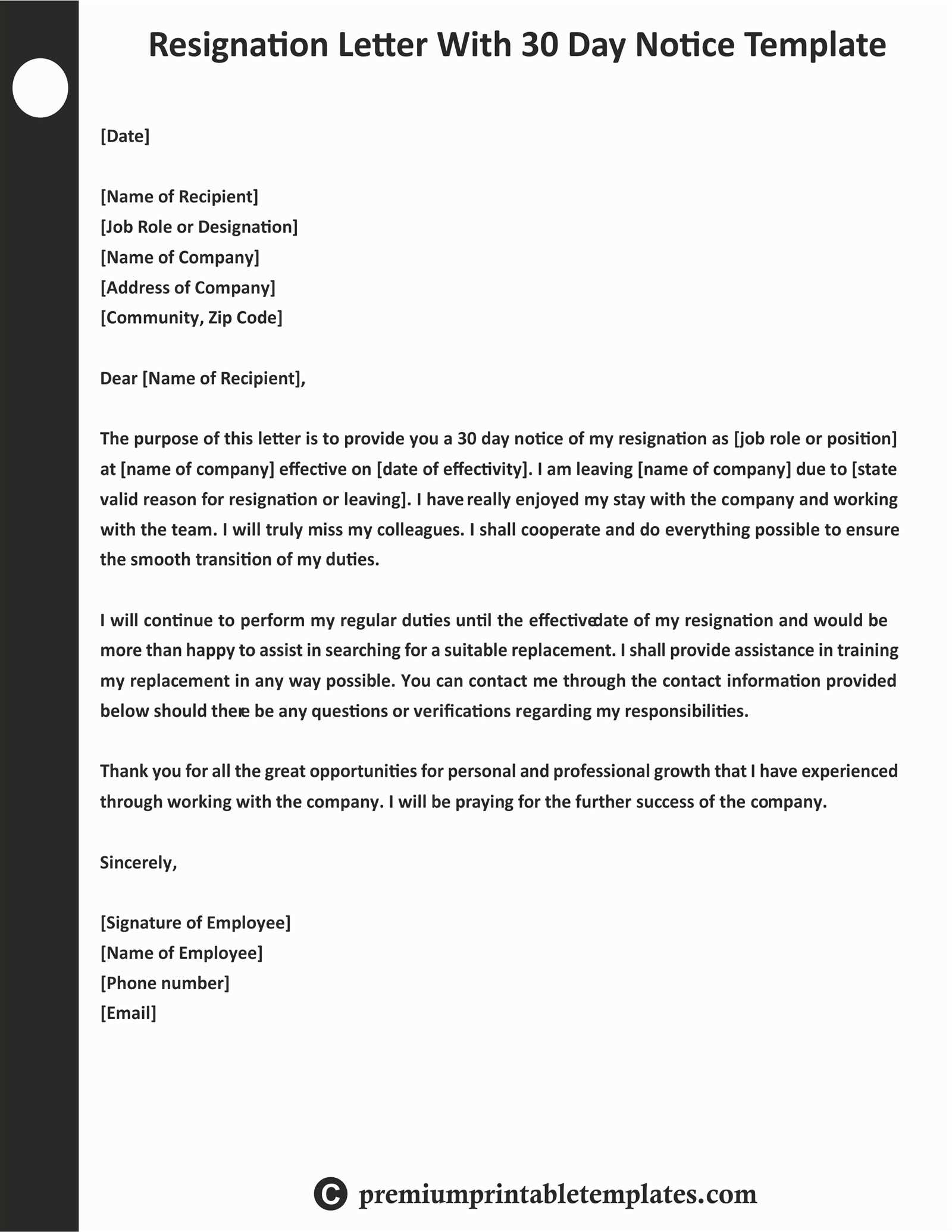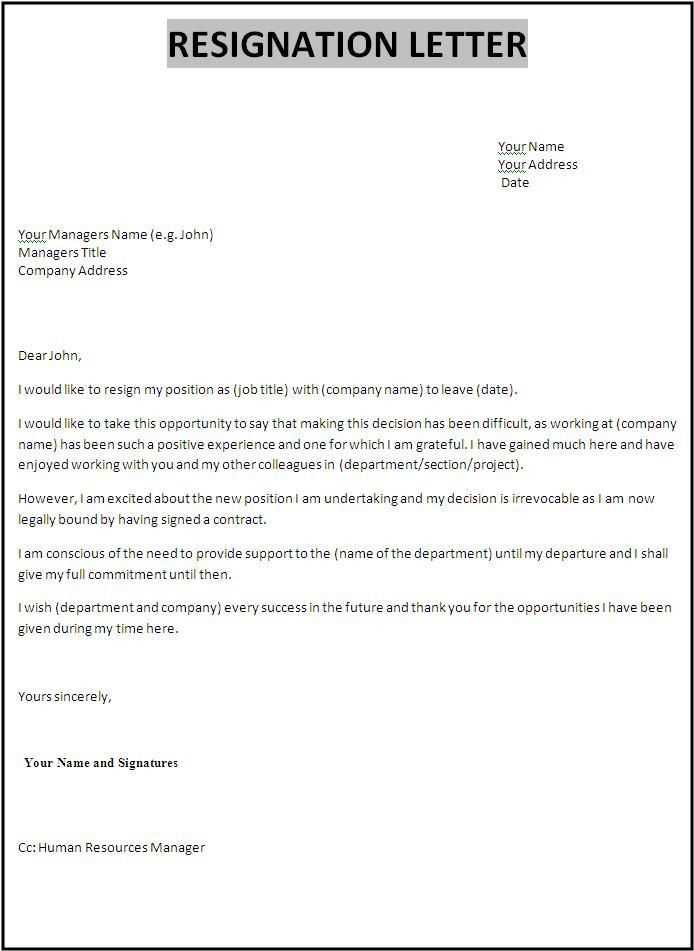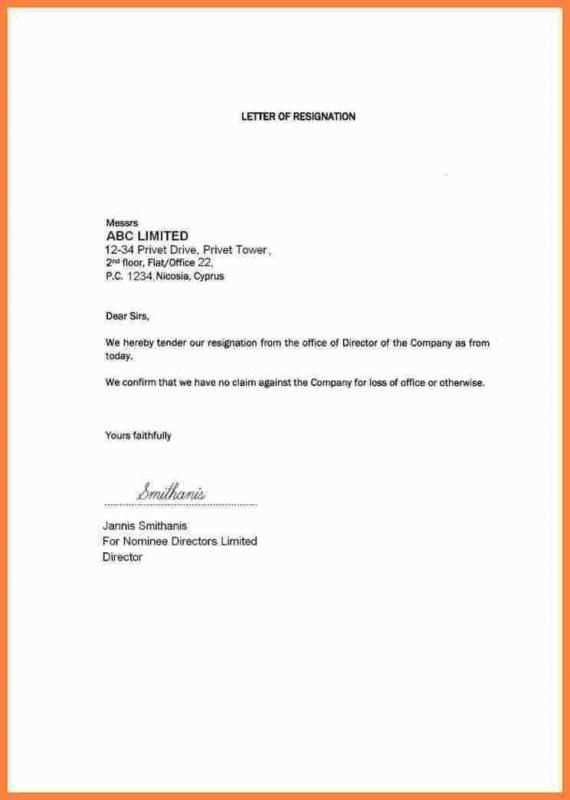30 day resignation letter template

Give your employer a clear and professional 30-day notice with this resignation letter template. It’s important to provide a formal written statement of your intention to leave, which not only ensures a smooth transition but also leaves a positive impression. Below is a template you can adapt to fit your situation, keeping the tone respectful and concise.
Dear [Supervisor’s Name],
I’m writing to formally notify you of my resignation from my position as [Your Position] at [Company Name], effective 30 days from today, [Last Working Day]. I appreciate the opportunities for personal and professional development that I have received during my time here.
I will do everything I can to make the transition as smooth as possible, including training a replacement or assisting in any other way you find helpful. Thank you again for the support and guidance throughout my tenure at [Company Name].
Sincerely,
[Your Name]
This template gives you a solid structure to use, focusing on key elements: clear intent, a specific timeline, and a polite offer to help with the transition. Customizing it with your details ensures it fits your circumstances while maintaining a professional tone.
30-Day Resignation Letter Template
A 30-day resignation letter provides your employer with a clear and concise way to announce your decision to leave the company, while maintaining professionalism. It’s important to offer sufficient notice to ensure a smooth transition. Below is a basic structure for your letter:
Subject: Resignation Notice – [Your Name]
Dear [Supervisor’s Name],
I am writing to formally resign from my position as [Your Job Title] at [Company Name], effective 30 days from today, [Date]. I appreciate the opportunities I’ve had during my time with the company and am grateful for the support from you and the team.
During the next 30 days, I am committed to assisting with the transition process and ensuring that all my responsibilities are completed or handed over as needed. Please let me know how I can be of help during this time.
Thank you again for the opportunity to be part of the team. I look forward to staying in touch and wish the company continued success.
Sincerely,
[Your Full Name]
This template gives a direct approach, leaving room for a smooth transition and maintaining professionalism. Make sure to customize it with your details before sending it off. Adjusting the tone to suit your workplace culture is also a good idea, but keep the focus on clarity and respect for the employer’s time.
How to Structure a 30-Day Resignation Letter
Begin with a formal greeting. Address the letter to your immediate supervisor or manager, using a respectful tone.
State the purpose of the letter clearly in the opening sentence. Mention your intention to resign and specify the exact date, which should be 30 days from the letter’s submission.
- Example: “I am writing to formally resign from my position as [Your Job Title] at [Company Name], effective [Date].”
Express gratitude for the opportunity you’ve had to work with the company. Keep this part sincere but concise, focusing on positive experiences.
- Example: “I appreciate the opportunities for growth and development during my time at [Company Name].”
Offer assistance during the transition period. Provide specifics on how you can help, such as training a replacement or finishing current projects. This shows professionalism and consideration.
- Example: “I am happy to assist with the transition process and ensure a smooth handover of my responsibilities.”
Close with a polite and professional sign-off. Reaffirm your gratitude and convey your best wishes for the company’s continued success.
- Example: “Thank you again for the opportunity. I wish you and the team all the best.”
End with a formal closing, such as “Sincerely” or “Best regards,” followed by your name.
Key Details to Include in a 30-Day Resignation Letter
A 30-day resignation letter should clearly outline the key facts of your departure. Start by specifying the date you are submitting your resignation. This gives clarity on your 30-day notice period. Next, state your final working day to avoid any confusion. Mention your position and express your gratitude briefly, keeping the tone positive and professional.
Include Clear Dates
Set the timeline for your resignation. The start date is the date you’re submitting the letter, and the end date is the final day of work. This ensures both you and your employer know the exact time frame. Example:
| Start Date | End Date |
|---|---|
| January 28, 2025 | February 27, 2025 |
Maintain Professional Tone

Although you are leaving, the tone should remain respectful. Express appreciation for the opportunities you’ve had. If you’re open to helping with the transition, mention it briefly, showing your willingness to support the team during the handover period.
How to Politely Inform Your Employer About Your Decision
Clearly state your decision in your resignation letter. Avoid unnecessary details and focus on the necessary points. For example, express gratitude for the opportunity while stating your intent to resign with the specified notice period. Keep your tone respectful, but firm.
Communicate Professionally and Respectfully
Directly mention the date when your resignation will take effect, ensuring you provide the standard 30-day notice. This gives your employer ample time to manage the transition. Use phrases such as “I am writing to formally resign from my position, effective [date],” to maintain clarity.
Acknowledge the Positive Aspects of Your Experience
Briefly acknowledge any positive experiences or skills gained during your time with the company. For example, “I have enjoyed my time here and am grateful for the opportunities for professional growth.” This will help maintain a positive relationship with your employer.
What to Do if You Need to Adjust Your Final Workday

If you need to adjust your final workday after submitting your resignation, communicate with your employer as soon as possible. Reach out to your manager or HR department, explaining the need for the change. Be polite but firm, and provide a new date that works for you while considering any outstanding tasks.
Offer Flexibility
Be prepared to show flexibility. If your employer is unable to accommodate the change, suggest a compromise that works for both parties. This might include offering to extend your departure by a day or two or adjusting your hours during the final days of work.
Update Your Resignation Letter
If the change is significant, amend your resignation letter. Write a brief note clarifying the new final day and express appreciation for your time at the company. Make sure the letter matches the updated details discussed with your employer. Sending this update ensures clarity for both sides.
Stay professional, focus on completing your duties, and offer assistance with the transition if needed. Remaining cooperative will leave a positive impression even as you adjust your departure date.
How to Handle Outstanding Work and Transition Plans

Before resigning, ensure that your tasks are properly handled and your responsibilities are transferred smoothly. Create a detailed list of ongoing projects and unfinished tasks. This will help both you and your employer track what needs attention before your departure.
Organize Your Current Projects
Take time to assess all active projects. Break them into smaller tasks, mark deadlines, and provide clear instructions on how to finish them. This will make the handover process easier for the person taking over. If possible, update any relevant documentation or notes to prevent confusion later.
Communicate with Your Team and Supervisor
Be transparent with your team about the work you’re transitioning. Schedule meetings with your supervisor to discuss your progress and any potential obstacles. This will give both parties an opportunity to align on expectations and ensure no tasks are overlooked.
Best Practices for Signing Off Professionally
End your resignation letter with clarity and respect. A strong conclusion leaves a positive final impression on your employer.
1. Express Gratitude
Thank your employer for the opportunities provided during your time with the company. Keep your tone sincere and specific.
- Acknowledge any personal growth or career advancement you experienced while employed.
- Highlight positive experiences or skills gained that will serve you in future roles.
2. Keep it Concise and Clear
Your closing statement should be brief and to the point. Avoid over-explaining your reasons for leaving.
- Clearly mention your last working day, based on your notice period.
- Use a formal but friendly closing, such as “Sincerely” or “Best regards.” Avoid informal phrases.
Follow these steps, and you’ll leave on a professional note, maintaining a strong relationship with your former employer for future opportunities.